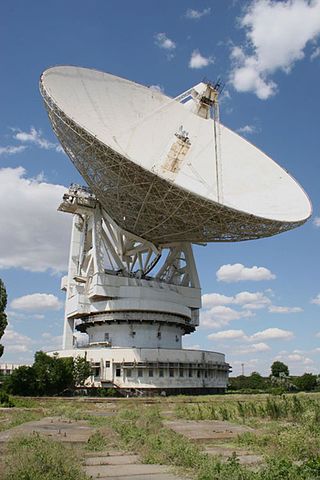
The Drake equation is a probabilistic argument used to estimate the number of active, communicative extraterrestrial civilizations in the Milky Way Galaxy.

The Fermi paradox is the discrepancy between the lack of conclusive evidence of advanced extraterrestrial life and the apparently high likelihood of its existence. As a 2015 article put it, "If life is so easy, someone from somewhere must have come calling by now."
The search for extraterrestrial intelligence (SETI) is a collective term for scientific searches for intelligent extraterrestrial life, for example, monitoring electromagnetic radiation for signs of transmissions from civilizations on other planets.

The Kardashev scale is a method of measuring a civilization's level of technological advancement based on the amount of energy it is capable of using. The measure was proposed by Soviet astronomer Nikolai Kardashev (1932–2019) in 1964 and was named after him.
Interstellar communication is the transmission of signals between planetary systems. Sending interstellar messages is potentially much easier than interstellar travel, being possible with technologies and equipment which are currently available. However, the distances from Earth to other potentially inhabited systems introduce prohibitive delays, assuming the limitations of the speed of light. Even an immediate reply to radio communications sent to stars tens of thousands of light-years away would take many human generations to arrive.
Extraterrestrial intelligence, or non-human intelligence, refers to hypothetical intelligent extraterrestrial life. No such life has ever been proven to exist in the Solar System except for humans on Earth, and its existence on other star systems is still speculative. The question of whether other inhabited worlds might exist has been debated since ancient times. The modern form of the concept emerged when the Copernican Revolution demonstrated that the Earth was a planet revolving around the Sun, and other planets were, conversely, other worlds. The question of whether other inhabited planets or moons exist was a natural consequence of this new understanding. It has become one of the most speculative questions in science and is a central theme of science fiction and popular culture.
Xenoarchaeology, a branch of xenology dealing with extraterrestrial cultures, is a hypothetical form of archaeology that exists mainly in works of science fiction. The field is concerned with the study of the material remains to reconstruct and interpret past life-ways of alien civilizations. Xenoarchaeology is not currently practiced by mainstream archaeologists due to the current lack of any material for the discipline to study.

The communication with extraterrestrial intelligence (CETI) is a branch of the search for extraterrestrial intelligence (SETI) that focuses on composing and deciphering interstellar messages that theoretically could be understood by another technological civilization. The best-known CETI experiment of its kind was the 1974 Arecibo message composed by Frank Drake.
Project Cyclops is a 1971 NASA project that investigated how SETI should be conducted. As a NASA product the report is in the public domain. The project team created a design for coordinating large numbers of radio telescopes to search for Earth-like radio signals at a distance of up to 1,000 light-years to find intelligent life. The proposed design involving between 1,000 and 2,500 steerable dishes of 100m diameter each was shelved due to costs. However, the report became the basis for much of the SETI work to follow.

The Teen Age Message (TAM) was a series of interstellar radio transmissions sent from the Yevpatoria Planetary Radar to six solar-type stars during August–September 2001. The structure of the TAM was suggested by Alexander Zaitsev, Chief Scientist at Russia's Institute of Radio-engineering and Electronics. The message's content and target stars were selected by a group of teens from four Russian cities, who collaborated in person and via the Internet. Each transmission comprised three sections: a sounding, a live theremin concert, and digital data including images and text. TAM was humanity's fourth Active SETI broadcast and the first musical interstellar radio message.

Christopher Rose is a professor of engineering, former associate provost at Brown University in Rhode Island and a founding member of WINLAB at Rutgers University in New Jersey. He was educated at the Massachusetts Institute of Technology; SB'79, SM'81, Ph.D'85 all in Course VI. On September 2, 2004, an article by Christopher Rose and Gregory Wright, titled Inscribed matter as an energy-efficient means of communication with an extraterrestrial civilization, appeared on the cover of Nature with the headline "Dear ET...".

A Bracewell probe is a hypothetical concept for an autonomous interstellar space probe dispatched for the express purpose of communication with one or more alien civilizations. It was proposed by Ronald N. Bracewell in a 1960 paper, as an alternative to interstellar radio communication between widely separated civilizations.
Active SETI is the attempt to send messages to intelligent extraterrestrial life. Active SETI messages are predominantly sent in the form of radio signals. Physical messages like that of the Pioneer plaque may also be considered an active SETI message. Active SETI is also known as METI.
A post-detection policy (PDP), also known as a post-detection protocol, is a set of structured rules, standards, guidelines, or actions that governmental or other organizational entities plan to follow for the "detection, analysis, verification, announcement, and response to" confirmed signals from extraterrestrial civilizations. Though no PDPs have been formally and openly adopted by any governmental entity, there is significant work being done by scientists and nongovernmental organizations to develop cohesive plans of action to utilize in the event of detection. The most popular and well known of these is the "Declaration of Principles Concerning Activities Following the Detection of Extraterrestrial Intelligence", which was developed by the International Academy of Astronautics (IAA), with the support of the International Institute of Space Law. The theories of PDPs constitute a distinct area of research but draw heavily from the fields of SETI, METI, and CETI.
The cultural impact of extraterrestrial contact is the corpus of changes to terrestrial science, technology, religion, politics, and ecosystems resulting from contact with an extraterrestrial civilization. This concept is closely related to the search for extraterrestrial intelligence (SETI), which attempts to locate intelligent life as opposed to analyzing the implications of contact with that life.

Technosignature or technomarker is any measurable property or effect that provides scientific evidence of past or present technology. Technosignatures are analogous to biosignatures, which signal the presence of life, whether intelligent or not. Some authors prefer to exclude radio transmissions from the definition, but such restrictive usage is not widespread. Jill Tarter has proposed that the search for extraterrestrial intelligence (SETI) be renamed "the search for technosignatures". Various types of technosignatures, such as radiation leakage from megascale astroengineering installations such as Dyson spheres, the light from an extraterrestrial ecumenopolis, or Shkadov thrusters with the power to alter the orbits of stars around the Galactic Center, may be detectable with hypertelescopes. Some examples of technosignatures are described in Paul Davies's 2010 book The Eerie Silence, although the terms "technosignature" and "technomarker" do not appear in the book.

The Berkeley SETI Research Center (BSRC) conducts experiments searching for optical and electromagnetic transmissions from intelligent extraterrestrial civilizations. The center is based at the University of California, Berkeley.

There are several methods currently used by astronomers to detect distant exoplanets from Earth. Theoretically, some of these methods can be used to detect Earth as an exoplanet from distant star systems.
The Rio scale was proposed in 2000 as a means of quantifying the significance of a SETI detection. The scale was designed by Iván Almár and Jill Tarter to help tell policy-makers how likely, from 0 to 10, it is that an extraterrestrial radio signal has been produced by an intelligent civilization.

The Byurakan Conference was held at the Byurakan Astrophysical Observatory in Armenia in 1964, at the initiative of the young scientist Nikolai Kardashev. It brought together a large number of Soviet astronomers and astrophysicists to take stock of knowledge and results in the search for traces of extraterrestrial life. The possibility of detecting extraterrestrial civilizations with the instruments available at the time was also discussed, as well as the criteria for communication with extraterrestrial intelligence.










